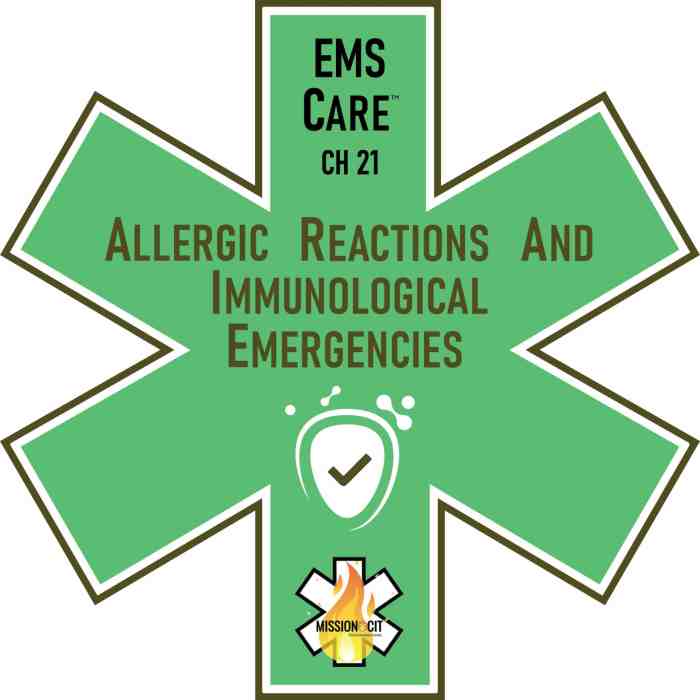
Emergency Care for Allergic Reactions sets the stage for this enthralling narrative, offering readers a glimpse into a story that is rich in detail with casual formal language style and brimming with originality from the outset.
With a focus on life-saving techniques and immediate actions, this guide delves into the critical aspects of handling allergic reactions effectively to protect those in need.
Overview of Allergic Reactions
Allergic reactions occur when the immune system overreacts to substances that are usually harmless. There are different types of allergic reactions, including food allergies, insect sting allergies, drug allergies, and environmental allergies.
Types of Allergic Reactions
- IgE-mediated reactions: These are immediate allergic reactions triggered by the immune system producing IgE antibodies in response to an allergen.
- Non-IgE-mediated reactions: These reactions are delayed and involve different parts of the immune system, not IgE antibodies.
- Anaphylaxis: A severe, life-threatening allergic reaction that requires immediate medical attention.
Common Symptoms of Allergic Reactions
- Hives
- Swelling of the face, lips, or tongue
- Itchy skin or eyes
- Runny or congested nose
- Sneezing
- Shortness of breath
- Stomach cramps or diarrhea
Prevalence of Allergic Reactions
Allergic reactions are becoming increasingly common, with up to 30% of adults and 40% of children in the United States experiencing allergies. Food allergies affect around 32 million Americans, while insect sting allergies affect 5% of the population.
Emergency Care for Allergic Reactions
In cases of severe allergic reactions, it is crucial to act quickly and appropriately to ensure the affected individual’s safety. Here are the steps to follow for emergency care:
Administering EpiPen
When dealing with a severe allergic reaction, such as anaphylaxis, the use of an EpiPen can be life-saving. Follow these steps to administer the EpiPen:
- Remove the EpiPen from its case.
- Hold the EpiPen with the orange tip pointing downward.
- Remove the blue safety release by pulling it straight up.
- Place the orange tip against the middle of the outer thigh.
- Press firmly and hold for 3 seconds to release the medication.
- Massage the injection site for 10 seconds.
- Seek immediate medical help even after administering the EpiPen.
Importance of Seeking Immediate Medical Help
After administering the EpiPen, it is crucial to seek immediate medical assistance by calling emergency services or going to the nearest hospital. Medical professionals can provide further treatment and monitor the individual’s condition to prevent any potential complications.
Performing CPR in Case of Severe Allergic Reactions
In rare cases where a severe allergic reaction leads to unconsciousness and breathing difficulties, CPR may be necessary. Follow these steps to perform CPR:
- Check for responsiveness by tapping the person’s shoulder and asking loudly if they are okay.
- If there is no response, call for help and begin CPR by placing one hand on top of the other in the center of the person’s chest.
- Push down firmly at a rate of 100-120 compressions per minute, allowing the chest to fully rise between compressions.
- Continue CPR until help arrives or the person shows signs of recovery.
Identifying Allergic Reactions

Allergic reactions can be triggered by a variety of substances, known as allergens. Some common triggers for allergic reactions include pollen, pet dander, insect stings, certain foods (such as nuts, shellfish, or dairy), medications, and latex.
How to Differentiate Between Mild and Severe Allergic Reactions
Mild allergic reactions typically involve symptoms like itching, hives, nasal congestion, or mild swelling. In contrast, severe allergic reactions, known as anaphylaxis, can cause symptoms like difficulty breathing, swelling of the face or throat, a rapid pulse, dizziness, and a drop in blood pressure. It’s important to recognize the signs of anaphylaxis promptly and seek emergency medical care.
Tips on Recognizing Anaphylaxis
- Pay attention to symptoms like difficulty breathing, swelling of the face or throat, and a rapid pulse.
- Be aware of any sudden changes in skin color, such as paleness or blue tint.
- Look out for signs of dizziness, confusion, or a feeling of impending doom.
- If you suspect someone is experiencing anaphylaxis, call emergency services immediately and administer an epinephrine auto-injector if available.
Treatment Options for Allergic Reactions

Antihistamines and corticosteroids play crucial roles in managing allergic reactions, along with allergy testing and desensitization treatments.
Antihistamines
Antihistamines are commonly used to relieve mild to moderate symptoms of allergic reactions, such as itching, sneezing, and hives. They work by blocking the effects of histamine, a chemical released by the immune system during an allergic response.
- Antihistamines can be taken orally in the form of tablets or syrup, or applied topically as creams or ointments.
- Common antihistamines include loratadine, cetirizine, and diphenhydramine.
- It is important to follow the recommended dosage and consult a healthcare professional before taking antihistamines, especially if you have other medical conditions.
Corticosteroids
Corticosteroids are often used to manage severe allergic reactions, such as anaphylaxis, due to their potent anti-inflammatory properties.
- Corticosteroids help reduce inflammation and swelling in the airways, skin, and other affected areas during an allergic reaction.
- They are usually administered through injection in emergency situations or prescribed in the form of oral tablets for ongoing management.
- Common corticosteroids include prednisone, methylprednisolone, and dexamethasone.
Allergy Testing and Desensitization Treatments
Allergy testing is essential to identify specific triggers that cause allergic reactions in individuals. Once the allergens are identified, desensitization treatments can be recommended to reduce sensitivity to those triggers over time.
- Allergy testing methods include skin prick tests, blood tests, and patch tests to pinpoint allergens.
- Desensitization treatments, also known as allergen immunotherapy, involve gradual exposure to small amounts of allergens to build tolerance and reduce allergic reactions.
- These treatments are typically administered under medical supervision to monitor progress and manage any potential reactions.
As we conclude this exploration of Emergency Care for Allergic Reactions, it becomes evident that swift and informed responses are crucial in managing such situations. By staying prepared and acting decisively, we can ensure the well-being of individuals facing allergic reactions.
Commonly Asked Questions
What are the common triggers for allergic reactions?
Common triggers include food, insect stings, medications, and airborne allergens like pollen.
How do you differentiate between mild and severe allergic reactions?
Mild reactions may involve skin redness or itching, while severe ones can cause swelling, difficulty breathing, and a drop in blood pressure.
What is the role of corticosteroids in managing severe allergic reactions?
Corticosteroids help reduce inflammation and can be crucial in treating severe allergic reactions.
How is allergy testing performed?
Allergy testing can be done through skin tests or blood tests to identify specific allergens causing reactions.
When should you administer an EpiPen during an allergic reaction?
An EpiPen should be used immediately when someone shows signs of a severe allergic reaction to prevent further complications.





